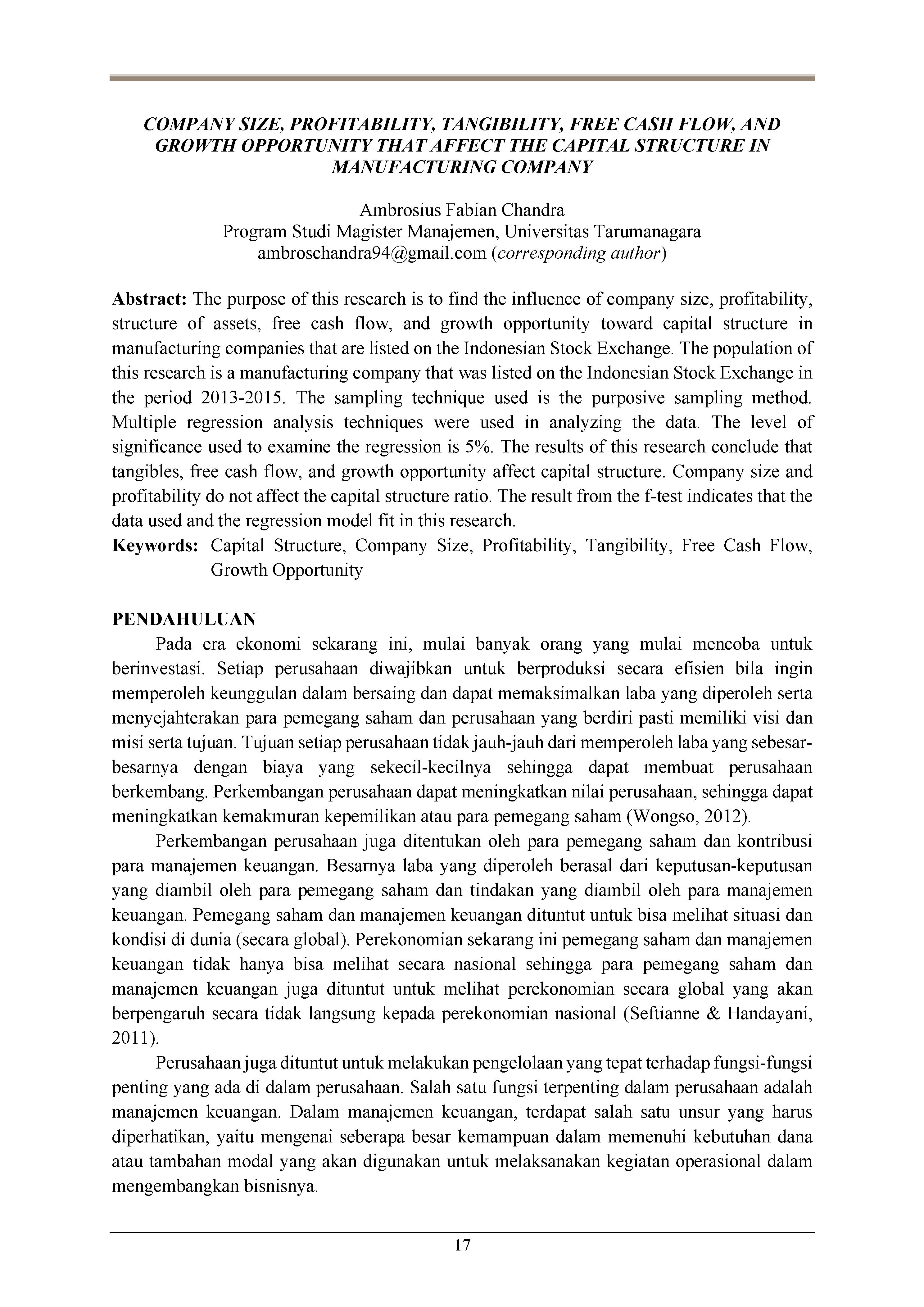Company size, profitability, tangibility, free cash flow, and growth opportunity that affect the capital structure in manufacturing company
Main Article Content
Abstract
The purpose of this research is to find the influence of company size, profitability, structure of assets, free cash flow, and growth opportunity toward capital structure in manufacturing companies that are listed on the Indonesian Stock Exchange. The population of this research is a manufacturing company that was listed on the Indonesian Stock Exchange in the period 2013-2015. The sampling technique used is the purposive sampling method. Multiple regression analysis techniques were used in analyzing the data. The level of significance used to examine the regression is 5%. The results of this research conclude that tangibles, free cash flow, and growth opportunity affect capital structure. Company size and profitability do not affect the capital structure ratio. The result from the f-test indicates that the data used and the regression model fit in this research.
Article Details

This work is licensed under a Creative Commons Attribution-NonCommercial-ShareAlike 4.0 International License.
This work is licensed under a Jurnal Manajemen Bisnis dan Kewirausahaan Creative Commons Attribution-ShareAlike 4.0 International License.
References
Albaity, M. S., & Chuan, A. H. S. (2013). Internationalization and capital structure: Evidence from Malaysian manufacturing firms. Asian Journal of Finance & Accounting, 5(2), 329–342. https://doi.org/10.5296/ajfa.v5i2.4533
Astuti, W. A., & Nurlaelasari. (2013). Pengaruh arus kas bebas dan profitabilitas terhadap kebijakan utang. Trikonomika, 12(1), 40–48. https://doi.org/10.23969/trikonomika.v12i1.458
Bangun, N., & Surianty, V. (2008). Analisis faktor-faktor yang mempengaruhi struktur modal (Studi empiris terhadap perusahaan manufaktur yang terdaftar di BEJ). Jurnal Akuntansi, 12(1), 35–47.
Brigham, E. F., & Houston, J. F. (2010). Dasar-dasar manajemen keuangan (A. A. Yulianto (trans.); 11th ed.). Salemba Empat.
Damayanti. (2013). Pengaruh struktur aktiva, ukuran perusahaan, peluang bertumbuh dan profitabilitas terhadap struktur modal (Studi pada perusahaan farmasi yang terdaftar di Bursa Efek Indonesia). Jurnal Perspektif Bisnis, 1(1).
Daulay, M. T. (2009). Pengaruh size, profitability dan growth of assets terhadap struktur modal pada industri makanan dan minuman yang go public di Bursa Efek Indonesia. Jurnal Ilmiah Abdi Ilmu, 2(2).
Febriyani, N., & Srimindarti, C. (2010). Faktor-faktor yang mempengaruhi struktur modal pada perusahaan-perusahaan LQ-45 di Bursa Efek Indonesia periode 2006-2008. Dinamika Keuangan dan Perbankan, 2(2), 138–159. https://www.unisbank.ac.id/ojs/index.php/fe1/article/view/2086
Ferdiansya, M. S., & Isnurhadi. (2013). Faktor-faktor yang mempengaruhi struktur modal pada perusahaan pertambangan yang terdaftar di Bursa Efek Indonesia. Jurnal Manajemen dan Bisnis Sriwijaya, 11(2), 133–148. https://doi.org/10.29259/jmbs.v11i2.3207
Firnanti, F. (2011). Faktor-faktor yang mempengaruhi struktur modal perusahaan manufaktur di Bursa Efek Indonesia. Jurnal Bisnis dan Akuntansi, 13(2), 119–128. https://doi.org/10.34208/jba.v13i2.153
Furi, V. R., & Saifudin. (2012). Faktor-faktor yang mempengaruhi struktur modal (Studi empiris pada perusahaan manufaktur yang terdaftar di BEI tahun 2009-2010). Jurnal Akuntansi, 1(2), 49–61.
Godfrey, J., Hodgson, A., Tarca, A., Hamilton, J., & Holmes, S. (2010). Accounting theory (7th ed.). Wiley.
Gunawan, A. (2011). Pengaruh profitabilitas dan perputaran aktiva terhadap struktur modal. Jurnal Ilmiah Manajemen dan Bisnis, 11(1), 12–24. http://jurnal.umsu.ac.id/index.php/mbisnis/article/view/111
Hartoyo, A. K. W., Khafid, M., & Agustina, L. (2014). Faktor-faktor yang mempengaruhi struktur modal perusahaan tekstil dan garmen di BEI. Accounting Analysis Journal, 3(2), 247–254. https://doi.org/10.15294/aaj.v3i2.4187
Indrawati, T., & Suhendro. (2006). Determinasi capital structure pada perusahaan manufaktur di Bursa Efek Jakarta periode 2000 - 2004. Jurnal Akuntansi dan Keuangan Indonesia, 3(1), 77–105. https://doi.org/10.21002/jaki.2006.04
Joni, & Lina. (2010). Faktor-faktor yang mempengaruhi struktur modal. Jurnal Bisnis dan Akuntansi, 12(2), 82–97. https://doi.org/10.34208/jba.v12i2.187
Nuswandari, C. (2013). Determinan struktur modal dalam perspektif pecking order theory dan agency theory. Dinamika Akuntansi, Keuangan dan Perbankan, 2(1), 92–102. https://www.unisbank.ac.id/ojs/index.php/fe9/article/view/2110
Prabansari, Y., & Kusuma, H. (2005). Faktor-faktor yang mempengaruhi struktur modal perusahaan manufaktur go public di Bursa Efek Jakarta. Sinergi: Kajian Bisnis dan Manajemen, Keuangan, 1–15. https://doi.org/10.20885/js.v0i0.935
Ramlall, I. (2009). Determinants of capital structure among non-quoted Mauritian firms under specificity of leverage: Looking for a modified pecking order theory. International Research Journal of Finance and Economics, 31, 83–92.
Riaz, F., & Afzal, M. (2011). Financial factors in capital structure decisions: Panel data analysis of Pakistan’s major manufacturing sectors. Interdisciplinary Journal of Contemporary Research in Business, 3(1), 310–326.
Ridloah, S. (2010). Faktor penentu struktur modal: Studi empirik pada perusahaan multifinansial. Jurnal Dinamika Manajemen, 1(2), 144–153. https://journal.unnes.ac.id/nju/jdm/article/view/2470
Rosdini, D. (2009). Pengaruh free cash flow terhadap dividend policy [Artikel Jurnal, Universitas Padjadjaran]. https://pustaka.unpad.ac.id/archives/17843
Sari, D. V., & Haryanto, A. M. (2013). Pengaruh profitabilitas, pertumbuhan aset, ukuran perusahaan, struktur aktiva dan likuiditas terhadap struktur modal pada perusahaan manufaktur di Bursa Efek Indonesia tahun 2008-2010. Diponegoro Journal of Management, 2(3), 1–11. https://ejournal3.undip.ac.id/index.php/djom/article/view/3204
Seftianne, & Handayani, R. (2011). Faktor-faktor yang mempengaruhi struktur modal pada perusahaan publik sektor manufaktur. Jurnal Bisnis dan Akuntansi, 13(1), 39–56. https://doi.org/10.34208/jba.v13i1.214
Sekaran, U., & Bougie, R. (2013). Research methods for business: A skill building approach (6th ed.). Wiley.
Shah, S. Q., Perveen, S., & Javed, N. (2013). Determinants of capital structure: An analysis of cement industry of Pakistan. International Journal of Information, Business and Management, 5(4), 172–194. https://ijibm.elitehall.com/IJIBM_Vol5No4_Nov2013.pdf
Widodo, M. W., Moeljadi, & Djawahir, A. H. (2014). Pengaruh tangibility, profitabilitas, pertumbuhan perusahaan, non debt tax shields, cash holding dan ukuran perusahaan terhadap struktur modal perusahaan (Studi pada perusahaan manufaktur yang listing di BEI tahun 2010-2012). JAM: Jurnal Aplikasi Manajemen, 12(1), 143–150. https://jurnaljam.ub.ac.id/index.php/jam/article/view/630
Wijaya, M. S. V., & Hadianto, B. (2008). Pengaruh struktur aktiva, ukuran, likuiditas, dan profitabilitas terhadap struktur modal emiten sektor ritel di Bursa Efek Indonesia: Sebuah pengujian hipotesis pecking order. Jurnal Ilmiah Akuntansi, 7(1), 71–84. https://doi.org/10.28932/jam.v7i1.324
Wongso, A. (2012). Pengaruh kebijakan dividen, struktur kepemilikan, dan kebijakan hutang terhadap nilai perusahaan dalam perspektif teori agensi dan teori signaling. Jurnal Ilmiah Mahasiswa Manajemen: JUMMA, 1(5), 1–6. https://doi.org/10.33508/jumma.v1i5.192
Yeniatie, & Destriana, N. (2010). Faktor-faktor yang mempengaruhi kebijakan hutang pada perusahaan nonkeuangan yang terdaftar di Bursa Efek Indonesia. Jurnal Bisnis dan Akuntansi, 12(1), 1–16. https://doi.org/10.34208/jba.v12i1.115


